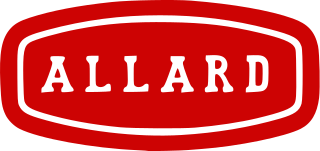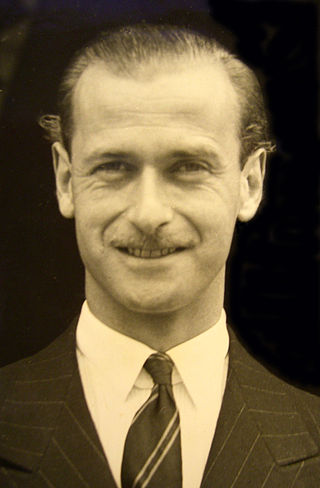
Allard Motor Company Limited was a London-based low-volume car manufacturer founded in 1945 by Sydney Allard in small premises in Clapham, south-west London. Car manufacture almost ceased within a decade. It produced approximately 1900 cars before it became insolvent and ceased trading in 1958. Before the war, Allard supplied some replicas of a Bugatti-tailed special of his own design from Adlards Motors in Putney.

Jösse Car was a sports car manufacturer founded in 1994 and located in Arvika, Sweden. They produced one vehicle, the two seater roadster Indigo 3000.

An overhead camshaft (OHC) engine is a piston engine in which the camshaft is located in the cylinder head above the combustion chamber. This contrasts with earlier overhead valve engines (OHV), where the camshaft is located below the combustion chamber in the engine block.

Singer Motors Limited was a British motor vehicle manufacturing business, originally a bicycle manufacturer founded as Singer & Co by George Singer, in 1874 in Coventry, England. Singer & Co's bicycle manufacture continued. From 1901 George Singer's Singer Motor Co made cars and commercial vehicles.

The Jaguar D-Type is a sports racing car that was produced by Jaguar Cars Ltd. between 1954 and 1957. Designed specifically to win the Le Mans 24-hour race, it shared the straight-6 XK engine and many mechanical components with its C-Type predecessor. Its structure, however, was radically different, with innovative monocoque construction and slippery aerodynamics that integrated aviation technology, including in some examples a distinctive vertical stabilizer.

The Riley RM is a series of executive cars and compact executive cars that were made by Riley Motors from 1945 until 1955. They were the last models developed independently by Riley before its parent company, Nuffield, merged with Austin to form BMC. The RM series was produced in Coventry until 1949, when production moved to the MG works at Abingdon. Until 1952, models were marketed as the Riley 1½ Litre and the Riley 2½ Litre. the term RM has been used retrospectively to encompass models produced before 1952.

The Aston Martin DB2 is a grand tourer that was sold by Aston Martin from May 1950 until April 1953. The successor to the 2-Litre Sports model, it had a comparatively advanced dual overhead cam 2.6 L Lagonda straight-6 engine in place of the previous overhead valve engine straight-four engine. It was available as a closed, 2-seater coupé which Aston Martin called a sports saloon, and later also as a drophead coupé, which accounted for a quarter of the model's total sales. The closed version had some success in racing.

Paramount Cars was a British company which produced the Paramount automobile between 1950 and 1956. Founded by WA Hudson and S Underwood from Derbyshire, the company initially manufactured cars in Swadlincote with production moving shortly after to Melbourne and then to Leighton Buzzard. Two models were produced, the Paramount Ten and the Paramount 1½-Litre.

The 1961 24 Hours of Le Mans was a motor race for Sports cars and Grand Touring cars staged at the Circuit de la Sarthe, Le Mans, France on 10 and 11 June 1961. It was the 29th Grand Prix of Endurance and the fourth race of the 1961 World Sportscar Championship. Ferrari and Maserati were the main contenders, with Aston Martin an outside chance.

The 1937 24 Hours of Le Mans was the 14th Grand Prix of Endurance. It took place at the Circuit de la Sarthe on 19 and 20 June 1937. The race was won by Jean-Pierre Wimille and Robert Benoist in Roger Labric's works-supported Bugatti team, in one of the streamlined new Type 57G cars, at a record pace and exceeding 2000 miles in the race for the first time.

Jean-Pierre Maréchal was an engineer and racing driver who died after his Aston Martin team car crashed in the first postwar running of the 24 Hours of Le Mans endurance race.

The Halford Special was a Grand Prix racing car of the 1920s built by engine designer Major Frank Halford on the chassis of an early Side Valve Aston Martin tourer. It was one of the most advanced British-built racing cars of the mid-1920s and had many racing successes. Halford himself was a freelance engine designer who did work for both the de Havilland Aircraft Company and Napier & Son.

The Singer Roadster is a nine tax horsepower open 2/4-seater sports-tourer automobile manufactured by Singer from 1939 until 1955. It was launched in March 1939 as an open version of Singer's Bantam saloon and using many Bantam parts.

Ecurie Bonnier, Ecurie Suisse, Joakim Bonnier Racing Team and Anglo-Suisse Racing Team were names used by Swedish racing driver Joakim Bonnier to enter his own cars in Formula One, Formula Two and sports car racing between 1957 and his death in 1972. Commonly the vehicles were entered for Bonnier himself, but he also provided cars for a number of other drivers during the period.
Ronald Godfrey (1887–1968), full name Henry Ronald Godfrey, was an English motor car design engineer of the first half of the 20th century possibly best known for his successful Singer-engined H R G thoroughbred sports cars built between 1935 and 1956.
The 1938 HRG Airline Coupe is a one-off British sports car powered by a 1500cc Triumph Gloria engine and gearbox. It was made by HRG Engineering Company with a body by Crofts Coachbuilding.
The Allard Palm Beach is a small British roadster built by Allard Motor Company between 1952 and 1958, with a Mark II introduced in 1956. Based on the chassis of the K3, but with only four- or six- cylinder engine options. Production only reached 80 units by the end of 1958 when manufacturing of the Palm Beach ended.
Godfrey-Proctor,, was a British car manufacturer founded by Henry Ronald Godfrey and Stuart Proctor at Richmond, Surrey in England. Godfrey left G.N. (Godfrey-Nash) to form H.R. Godfrey Motors, providing G.N. spares and rebuilds, which evolved into Godfrey and Proctor who both serviced GN's and produced their own car based on the Austin 7. About 10 cars had been produced when the company ceased trading in 1928.

The Singer Nine is a car which was produced by Singer Motors Limited from February 1933 to 1937, and then again from 1939 until 1949 as a Roadster only. It was offered as a new economy model, replacing the earlier Singer Junior series. The "Nine" engine was briefly fitted inside the body of the earlier Junior as a solution to production problems in 1932. The hybrids are known as the "Junior Nine" and are recognisable by the cursive "Nine" badge adorning the radiator stone-guard.
Jacques Coune (1924-2012) was a Belgian coach builder who designed and built a variety of specials via his company Carrosserie Jacques Coune, and was a co-founder of the Ecurie Nationale Belge F1 team.





















